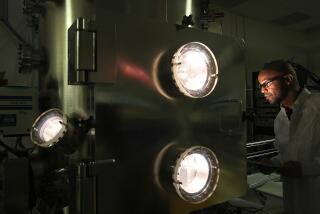Los Angeles lands shuttle Endeavour
The space shuttle Endeavour — assembled in Palmdale and celebrated as the “jewel of the fleet” — is coming home to Southern California for permanent display at the California Science Center, NASA announced Tuesday, ending a fierce museum competition for among the rarest of space artifacts.
“This is a dream come true,” said Jeffrey N. Rudolph, president of the Los Angeles museum.
Endeavour has yet to retire, though. Its final flight, scheduled for April 29, will be commanded by Capt. Mark E. Kelly, husband of Gabrielle Giffords, the Arizona congresswoman severely injured in the Tucson shooting in January.
Museum officials said the orbiter, which has circled earth 4,429 times and traveled more than 103 million miles in 24 missions, could arrive in Los Angeles by the end of the year, although NASA said preparations for the trip could take more time.
Endeavour’s return is significant because for three decades the region played a crucial role in the shuttles’ development. The program pumped hundreds of millions of dollars into the economy and employed thousands of workers, a source of pride for Southern California’s once-thriving aerospace industry.
And then there was the occasional sonic boom, reminding Southern Californians that they owned a piece of space exploration history, every time the shuttle landed at Edwards Air Force Base.
NASA Administrator Charles Bolden announced the final landing locations for the spacecraft, which he called “national treasures,” at a Kennedy Space Center ceremony marking the 30th anniversary of the first shuttle launch. The last shuttle mission is scheduled for late June.
The shuttle Atlantis will go to Florida’s Kennedy Space Center and Discovery to the Smithsonian National Air and Space Museum. The test orbiter Enterprise, now on exhibit at the Smithsonian in northern Virginia, will go to New York’s Intrepid Sea, Air & Space Museum.
Having won a shuttle will not only enhance the California Science Center’s prestige but give the city an economic boost. “To have one of only four things that exist in the world makes it a prize, a very valuable prize,” said Valerie Neal, curator at the Smithsonian National Air and Space Museum.
The science museum plans to make Endeavour a centerpiece of its upcoming $170-million third wing, which will be devoted to aeronautics and space exploration. A NASA official said it could take about a year to prepare the shuttle for transport, including ridding it of toxins. And it will probably take about five years for the science center to complete its permanent home for Endeavour.
In the meantime, Rudolph said, the museum intends to find a location to temporarily house the shuttle, and a makeshift exhibit could be opened to the public sooner.
Rudolph was already working on transportation logistics for the five-story-tall orbiter, which has a 78-foot-wingspan.
Endeavour will be flown into the area atop a Boeing 747. From the airport, possibly Los Angeles International Airport, it will probably be towed to a storage facility via wide surface streets, unobstructed by freeway overpasses or electrical wires, Rudolph said.
The center has maneuvered aircraft through city streets before, with the arrival of the 150-foot-long Douglas DC-8 now on display outside the Exposition Park museum.
Los Angeles was widely considered an underdog in the shuttle competition.
Robert Yowell, a former NASA flight controller who monitored online guessers of NASA’s picks, said “not one thought L.A. was going to get one.”
Other museums had high-profile efforts led by astronauts. Politicians joined in with heavy arm twisting.
In contrast, the California Science Center, a free museum run by the state and a nonprofit group, mounted a low-key campaign. An official emphasized its widespread appeal as a general science museum, its 1.4 million annual visitors and its plans to give the aerospace gallery a separate building. It is expected to host as many as 2 million visitors a year with the arrival of the shuttle.
“We did a good job in explaining how we would use it to educate and inspire, which is what NASA is wanting to do,” Rudolph said.
The museum’s win also comes with a heavy responsibility. It now must raise tens of millions of dollars to bring the shuttle to Los Angeles, and continue its effort to raise money for its aeronautic wing.
Rudolph said the center had a strong fundraising track record, collecting $130 million over six years to help fund the museum’s new home, which opened in 1998, and $165 million over another six years to pay for its second Ecosystems building, which opened in 2010.
If the museum cannot show sufficient progress to NASA that it can pay the federal agency the $28.8 million to transport Endeavour to Los Angeles, “there is a risk that California will not have an orbiter.”
Rudolph said he thought it wasn’t appropriate to begin raising funds before the center knew for certain it would receive a shuttle.
The $1.8-billion Endeavour rolled off Rockwell International’s production line in Palmdale in 1991. It replaced the Challenger, which exploded in 1986, killing all seven aboard. Endeavour is named after a ship used by 18th century British explorer James Cook.
The announcement was a blow to other regions that lobbied hard to receive a shuttle — perhaps none more than Texas, home of NASA mission control. Its rejection prompted calls for congressional investigations and charges that politics played a role in the decision, which NASA disputed.
NASA officials said they were making shuttle artifacts available to other museums.
“In the end, these choices provide the greatest number of people with the best opportunity to share in the history and accomplishments of NASA’s remarkable space shuttle program,” Bolden said. “These facilities we’ve chosen have a noteworthy legacy of preserving space artifacts and providing outstanding access to U.S. and international visitors.”
More to Read
Start your day right
Sign up for Essential California for news, features and recommendations from the L.A. Times and beyond in your inbox six days a week.
You may occasionally receive promotional content from the Los Angeles Times.








